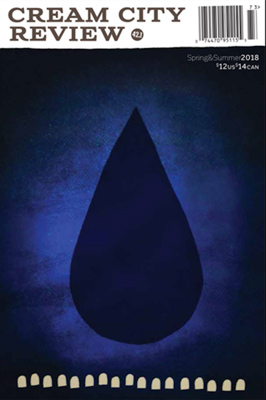Cream City Review – Spring/Summer 2018
 Cream City Review, named for the cream-colored bricks that made Milwaukee famous, is anything but brick-like. The Spring/Summer 2018 issue is slim and elegantly designed, decorated front and back with intriguing teardrops, a blue glow, the earth, and what look like gravestones. In a letter to their readers, editors Mollie Boutell and Caleb Nelson write, “The daily news cycle is a swirl of darkness and absurdity, so it should not surprise us that the landscape of contemporary literature reflects a similar mood.” The current issue plays with darkness and light, sometimes descending deeply into the former, but always doing so for the sake of art, illuminating through darkness, showing both the path and the ways that we humans are led astray.
Cream City Review, named for the cream-colored bricks that made Milwaukee famous, is anything but brick-like. The Spring/Summer 2018 issue is slim and elegantly designed, decorated front and back with intriguing teardrops, a blue glow, the earth, and what look like gravestones. In a letter to their readers, editors Mollie Boutell and Caleb Nelson write, “The daily news cycle is a swirl of darkness and absurdity, so it should not surprise us that the landscape of contemporary literature reflects a similar mood.” The current issue plays with darkness and light, sometimes descending deeply into the former, but always doing so for the sake of art, illuminating through darkness, showing both the path and the ways that we humans are led astray.
 Cream City Review, named for the cream-colored bricks that made Milwaukee famous, is anything but brick-like. The Spring/Summer 2018 issue is slim and elegantly designed, decorated front and back with intriguing teardrops, a blue glow, the earth, and what look like gravestones. In a letter to their readers, editors Mollie Boutell and Caleb Nelson write, “The daily news cycle is a swirl of darkness and absurdity, so it should not surprise us that the landscape of contemporary literature reflects a similar mood.” The current issue plays with darkness and light, sometimes descending deeply into the former, but always doing so for the sake of art, illuminating through darkness, showing both the path and the ways that we humans are led astray.
Cream City Review, named for the cream-colored bricks that made Milwaukee famous, is anything but brick-like. The Spring/Summer 2018 issue is slim and elegantly designed, decorated front and back with intriguing teardrops, a blue glow, the earth, and what look like gravestones. In a letter to their readers, editors Mollie Boutell and Caleb Nelson write, “The daily news cycle is a swirl of darkness and absurdity, so it should not surprise us that the landscape of contemporary literature reflects a similar mood.” The current issue plays with darkness and light, sometimes descending deeply into the former, but always doing so for the sake of art, illuminating through darkness, showing both the path and the ways that we humans are led astray.
“Sometimes They Scream,” a powerful piece of fiction by Eric Magnuson, comes with a “content advisory” note, warning the reader of potential triggers involving violence and sexual assault. Though trigger warnings at times can feel overly cautious, Magnuson’s piece, which features workers tasked with censoring the internet’s most heinous and overtly sexual content, certainly benefits from a buffer. The story’s protagonist, Rebecca, has outlasted nearly everyone in her job, which she’s held for a year and two months, becoming increasingly jaded in the process. Her significant other, Brett, bears the brunt of this swelling disinterest in the world outside of work. The one person she does care for, a new colleague named Gina, begins to fall apart when a particularly terrible video appears on her screen, but even that fails to shake Rebecca’s humanity loose, committed as she is to the parade of human misery that enters her life in digital waves. Magnuson’s piece is a moving critique of internet culture and what technology allows us to become.
In “Wake,” Christine Robbins commemorates a lost child, writing bluntly, beautifully, and tragically about changed meanings and what is wished undone.
I left
The door wide. I wished
For something’s escape. And hungerKeeps its watch. And the mind
Becomes a wake.
The poem blends loss with an understanding of how the natural world rolls on, its creatures searching and surviving, adapting to what comes. Burial does not stop the way we disappear from the world, from becoming a meal for bugs and other creatures who live under the earth. “When we die, do we go out,” Robbins writes, “Or does everything else come in?”
In “Yes, Mike?” a short piece by Jonathan Cardew, a parent is meant to talk to her child’s class about dinosaurs, but isn’t “feeling it,” to the surprise of the eager students and their twenty-five-year-old teacher, whom the protagonist dubs “gorgeous.” Instead, the teacher steps in, taking questions from the class, anxiously spinning the guest speaker’s snub. Impressively, Cardew has managed to fit a tremendous amount of story into a tiny space, creating layers of meaning that exist off the page, blending humor and desire, lampooning the classroom dynamic—including the boy with the perpetually raised hand—and leaving the reader desiring more. Cardew has two other flash pieces that follow the first, but they lack the fullness of their predecessor: the second piece is a scrap, a character sketch that doesn’t feel fully developed, and the third piece, unlike—“Yes, Mike?”—feels cramped in its paltry two pages.
For the most part, the rest of the issue is satisfying. “We Are Not Alone” by John Sibley Williams, “Anecdotal” by Elizabeth McLagan, and “Wolf Diary” by Emily Cataneo are all worthy contributions, and the other writing is generally successful. However, there is room for improvement. The artwork is fine, but not special, and though the editors have put themselves out there with a few experimental poems and prose pieces—one of which was supposed to have a companion sound component on the website that doesn’t seem to be available—these contributions aren’t particularly successful. It’s the more traditional work that shines through.
Still, it is vital to test boundaries, to take risks, and the editors’ passion for the written word, for exploration, is evident throughout the issue. Their community is ours. As the editors remind us in their note, “We need each other,” especially in tumultuous times. If we make the effort, we can learn from one another, grow, make sense of anything. There are lessons even in hardship. As John Sibley Williams writes:
Even the storms
that shatter us hesitate a moment, as
if in reverie, prayer, before making
us what we are.
Review by Craig Ledoux




